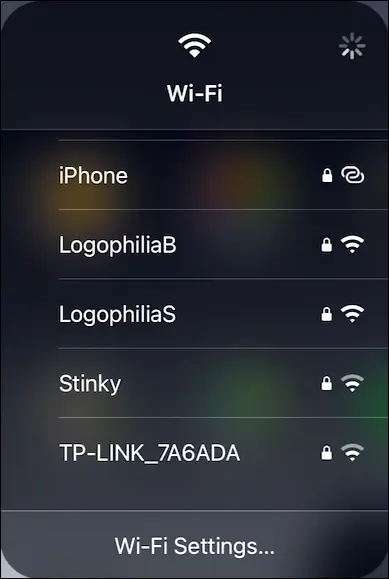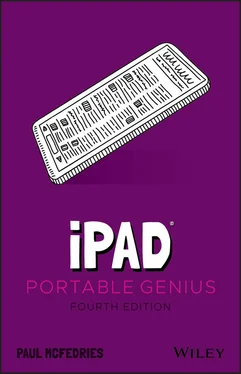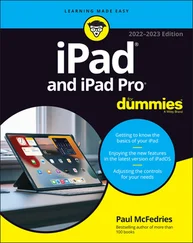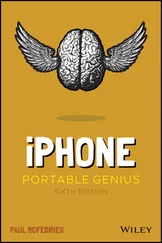1 Open the Settings app.
2 Tap Wi-Fi. iPadOS displays the Wi-Fi settings.
3 Tap the More Info icon (the circled i ) to the right of the network you want to forget. iPadOS displays the network’s settings.
4 Tap Forget this Network. iPadOS asks for confirmation.
5 Tap Forget. iPadOS discards the connection data for the network.
Shutting off the Wi-Fi antenna
Your iPad uses its built-in Wi-Fi antenna to constantly scan for available Wi-Fi networks, which brings two main advantages:
You know the list of nearby networks is always up do date.
It provides greater accuracy to location-based services such as the Maps app.
However, there’s also a big disadvantage to this constant network scanning: It drains your iPad’s battery. If you won’t be joining any Wi-Fi networks for a while, you can reduce the load on your tablet’s battery by shutting off the Wi-Fi antenna. Here’s how:
1 Open the Settings app.
2 Tap Wi-Fi. iPadOS displays the Wi-Fi settings.
3 Tap the Wi-Fi switch to Off. iPadOS shuts off the Wi-Fi antenna, disconnects from your current network, and no longer scans for nearby networks.
To resume the Wi-Fi thing, repeat these steps to turn the Wi-Fi switch to On.
An easier way to toggle the Wi-Fi antenna is to display the Control Center and then tap the Wi-Fi icon.
Tethering to an iPhone Internet Connection
If you have a Wi-Fi–only iPad, you might think you’re stuck if you’re out and about, need to use the Internet, and there’s no Wi-Fi in sight. If you have an iPhone with you, then you can work around this problem by using a nifty feature called Personal Hotspot, which enables you to configure your iPhone as a kind of Internet hub or gateway device — something like the hotspots that are available in coffee shops and other public areas.
You can connect your iPad to your iPhone via Wi-Fi, and your tablet can then use the iPhone cellular Internet connection to get online. This is often called Internet tethering . The downside is that some providers will charge you extra for tethering. This is slowly changing, but read the fine print on your cellular contract to be sure.
Your first step down the Personal Hotspot road is to activate the feature on your iPhone. Here’s how it’s done:
1 Open the Settings app.
2 Tap Personal Hotspot. Your iPhone opens the Personal Hotspot screen.
3 Tap the Allow Others to Join switch to the On position.
4 Tap Wi-Fi Password, enter a password, and then tap Done.
With Personal Hotspot enabled on your iPhone, follow these steps to connect your iPad to it via Wi-Fi:
1 Open the Settings app.
2 Tap Wi-Fi. iPadOS displays the Wi-Fi settings. You can also open the Control Center, long press anywhere in the section that includes the Wi-Fi icon, and then long press the Wi-Fi icon.
3 In the network list, tap the one that has the same name as your iPhone, as shown in Figure 2.4. Your tablet prompts you for the Wi-Fi password.
4 Type the Personal Hotspot Wi-Fi password and then tap Join. In the status bar, your iPad shows the Personal Hotspot icon, which is two interconnected rings, as shown in Figure 2.5.

2.4To make a Wi-Fi connection to the iPhone hotspot, display the list of wireless networks and then select the network with the same name as your iPhone.

2.5When your iPad is tethered, it shows the Personal Hotspot icon in the status bar.
If you have a cellular iPad, you can use it as a Personal Hotspot if your data plan allows for Internet tethering. Tap Settings, tap Cellular Data, tap Personal Hotspot, and then tap the Allow Others to Join switch to On.
Working with Cellular-Enabled iPads
Some iPad models come with a cellular chip and antenna that enable those tablets to connect to a cellular network. The big advantage here is that you can use your tablet online even when there’s no Wi-Fi within miles of your location. As long as you’re within the cellular network’s coverage area, you can send and receive email, surf the web, map a location, and perform all your other favorite online activities. The one disadvantage is that cellular connections aren’t free. You’ll need a data plan from your favorite (if that’s the right word) cellular provider.
Tracking cellular data usage
Having a data plan with a cellular provider means never having to worry about getting access to the network. However, unless you’re paying for unlimited access (lucky you!), you should be worrying about going over whatever maximum amount of data usage your plan provides per month. That’s because going over your data max means you start paying through the nose for each megabyte, and you can run up a hefty bill in no time.
To avoid that, keep track of your cellular data usage by following these steps:
1 Open the Settings app.
2 Tap Cellular. The Cellular settings appear.
3 In the Cellular Data section, read the Current Period and Current Period Roaming values.
4 If you’re at the end of your data period, tap Reset Statistics to get a fresh start for the new period.
Shutting off the LTE antenna
LTE cellular connections are fast, but they use a lot of battery power because the LTE antenna is constantly scanning for an LTE signal — even if you’re on a Wi-Fi network. If your iPad battery is running low, you can switch to the slower — but lower-powered — 3G cellular antenna by following these steps:
1 Open the Settings app.
2 Tap Cellular. The Cellular settings appear.
3 Tap Cellular Data Options.
4 Tap Voice & Data. The Voice & Data settings appear.
5 Tap 3G. Your iPad shuts off the LTE antenna and turns on the 3G antenna.
Preventing your iPad from using cellular data
If you’re bumping up against the monthly ceiling of your iPad’s cellular data plan, you’ll want to be careful not to exceed your cap because that can get expensive in a hurry. If you don’t trust yourself (or anyone who might have access to your iPad), you can just shut off your iPad’s access to cellular data. Here are the steps to follow:
1 Open the Settings app.
2 Tap Cellular. The Cellular settings appear.
3 Tap the Cellular Data switch to Off.
Controlling app access to cellular data
Preventing your iPad from using any cellular data, as I describe in the previous section, is a drastic move, particularly if you know that a particular high-bandwidth app (I’m looking at you , YouTube!) is causing most of the trouble. In that case, you can configure your iPad to disable access to cellular data app-by-app. Here’s how:
1 Open the Settings app.
2 Tap Cellular. The Cellular settings appear.
3 In the Cellular Data section, for each app that you want to prevent from using cellular data, tap the app’s switch to Off.
Читать дальше
















